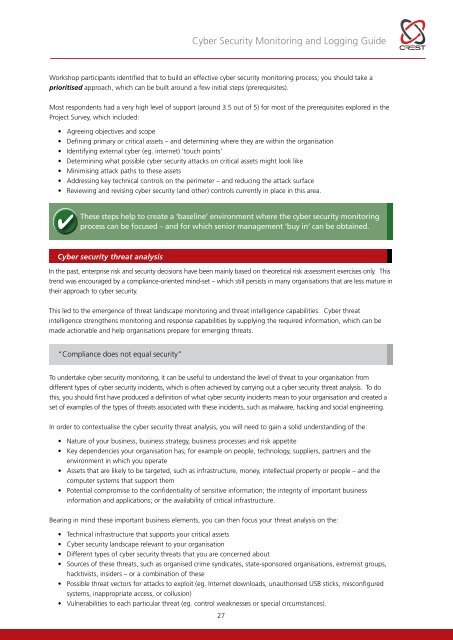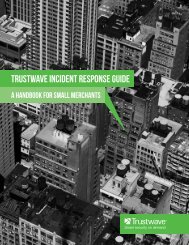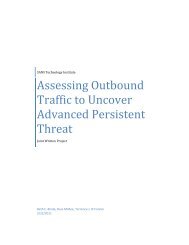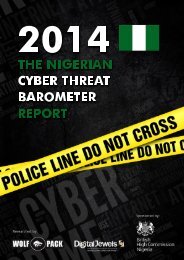Cyber-Security-Monitoring-Guide
Cyber-Security-Monitoring-Guide
Cyber-Security-Monitoring-Guide
Create successful ePaper yourself
Turn your PDF publications into a flip-book with our unique Google optimized e-Paper software.
<strong>Cyber</strong> <strong>Security</strong> <strong>Monitoring</strong> and Logging <strong>Guide</strong>Workshop participants identified that to build an effective cyber security monitoring process; you should take aprioritised approach, which can be built around a few initial steps (prerequisites).Most respondents had a very high level of support (around 3.5 out of 5) for most of the prerequisites explored in theProject Survey, which included:• Agreeing objectives and scope• Defining primary or critical assets – and determining where they are within the organisation• Identifying external cyber (eg. internet) ‘touch points’• Determining what possible cyber security attacks on critical assets might look like• Minimising attack paths to these assets• Addressing key technical controls on the perimeter – and reducing the attack surface• Reviewing and revising cyber security (and other) controls currently in place in this area.These steps help to create a ‘baseline’ environment where the cyber security monitoringprocess can be focused – and for which senior management ‘buy in’ can be obtained.<strong>Cyber</strong> security threat analysisIn the past, enterprise risk and security decisions have been mainly based on theoretical risk assessment exercises only. Thistrend was encouraged by a compliance-oriented mind-set – which still persists in many organisations that are less mature intheir approach to cyber security.This led to the emergence of threat landscape monitoring and threat intelligence capabilities. <strong>Cyber</strong> threatintelligence strengthens monitoring and response capabilities by supplying the required information, which can bemade actionable and help organisations prepare for emerging threats.“Compliance does not equal security”To undertake cyber security monitoring, it can be useful to understand the level of threat to your organisation fromdifferent types of cyber security incidents, which is often achieved by carrying out a cyber security threat analysis. To dothis, you should first have produced a definition of what cyber security incidents mean to your organisation and created aset of examples of the types of threats associated with these incidents, such as malware, hacking and social engineering.In order to contextualise the cyber security threat analysis, you will need to gain a solid understanding of the:• Nature of your business, business strategy, business processes and risk appetite• Key dependencies your organisation has; for example on people, technology, suppliers, partners and theenvironment in which you operate• Assets that are likely to be targeted, such as infrastructure, money, intellectual property or people – and thecomputer systems that support them• Potential compromise to the confidentiality of sensitive information; the integrity of important businessinformation and applications; or the availability of critical infrastructure.Bearing in mind these important business elements, you can then focus your threat analysis on the:• Technical infrastructure that supports your critical assets• <strong>Cyber</strong> security landscape relevant to your organisation• Different types of cyber security threats that you are concerned about• Sources of these threats, such as organised crime syndicates, state-sponsored organisations, extremist groups,hacktivists, insiders – or a combination of these• Possible threat vectors for attacks to exploit (eg. Internet downloads, unauthorised USB sticks, misconfiguredsystems, inappropriate access, or collusion)• Vulnerabilities to each particular threat (eg. control weaknesses or special circumstances).27










